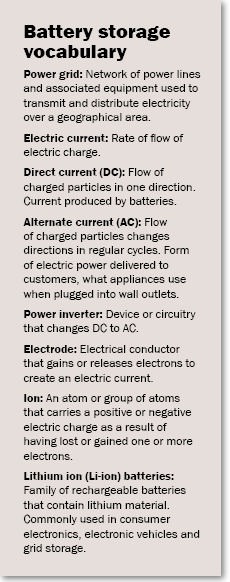Series: Energy storage is evolving, but careful analysis comes first

Editor’s note: Energy storage is a hot topic in the utility industry. Over the next weeks and months
we will dive deeper into the topic to give customers a complete picture of the technology.
Part 1: The basics of battery storage
*********************************
Renewable energy is growing by leaps and bounds. Many utilities, including Omaha Public Power District are working toward a more sustainable future. But adding more wind and solar generation is not enough to keep reliable power flowing to customers.
“It’s not always windy. The sun doesn’t always shine,” said Mike Lisowyj, alternative energy specialist for OPPD.
That’s where energy storage technology can be a big benefit, Lisowyj said. But it does present some potential hurdles in terms of cost and capability.
Generating energy
“To understand how energy storage works, you must first understand what kind of power is produced by each type of generation,” Lisowyj said.
There are two basic types of electricity generation – direct current (DC) and alternating current (AC). With DC, the flow of charged particles (electrons) is constant and moves in one direction.
With AC, the movement oscillates and repeats, changing over time. The up curve indicates the current flowing in a positive direction and the down curve signifies the alternate cycle where the current moves in a negative direction.
“Wind turbines produce AC, like coal-fired plants, turning a generator to produce energy,” Lisowyj said. “Solar panels produce DC, which inverters convert to AC (for use by the power grid).”
The way the grid is currently set up is that energy is generated on-demand where it is used instantaneously. With many alternative technologies, peak energy generation may occur when demand is low which can create excess energy.
Save some for later
Currently, grid operators must constantly match energy supply with demand. Energy storage allows utilities to save excess energy not needed by customers for later use. The process is similar to charging a cell phone. But there are a few more steps involved.
“Today’s batteries can only produce DC power,” Lisowyj said. “Energy goes into an array of batteries, typically housed within a shipping container or a building structure. When the energy is needed, the inverters are used again, but this time to convert the energy stored into AC,” he said.
“Once the power is transformed, it is stepped up in voltage, and sent to an on-site substation or directly to a distribution or transmission line.”
Different technologies
Lisowyj said there are a number of energy storage systems available right now, using a wide variety of technology, such as pumped-storage hydropower, flow batteries, flywheels, lithium ion, liquid-air, and molten salt to name a few.
Pumped-storage hydropower (PSH) dominates energy storage around the world. This is mainly due to it being an older more established technology. PSH projects have been providing energy storage capacity in the United States and Europe since the 1920s.
 But lithium ion or Li-ion batteries are used for most new, utility-scale storage projects. They are attractive because of their fast response and number of charging cycles.
But lithium ion or Li-ion batteries are used for most new, utility-scale storage projects. They are attractive because of their fast response and number of charging cycles.
“Each Li-ion battery is made of one or more power-generating cells containing a positive electrode made of a lithium containing material, a negative electrode made of carbon, and an electrolyte between them,” Lisowyj explained.
When the battery is charging, the positive electrode (cathode) gives up some of its lithium ions. The ions move through the electrolyte to the negative electrode (anode), where they are captured. The battery takes in and stores energy during this process.
When the battery discharges, the lithium ions move back across the electrolyte to the cathode. This produces energy to use on the grid.
Cost of technology
As with any newer technology, battery storage is costly. Utility-scale lithium-ion batteries cost around $1.5 million per megawatt for a four-hour duration battery.
But prices are declining – in part due to scaling of systems.
Li-ion battery costs fell 80% between 2010 and 2017. And they’re projected to fall another 52% between 2018 and 2030.
OPPD looking into storage options
“OPPD is investigating energy storage technology and is analyzing scenarios where investing in the technology would be beneficial for the utility and its customers,” Lisowyj said.
One reason the utility has not yet taken the leap is safety.
“If Li-ion batteries short-circuit, cells can enter a state called ‘thermal runaway,’ where they continue heating to a point where they may ignite,” Lisowyj said.
This past April, a utility-scale battery facility in Arizona caught fire, and at least 23 South Korean plants have caught fire since August 2017.
“Very few of these fires have been reported in the U.S. But if OPPD considers Li-ion battery storage in the near future, we will need to use the existing operating experience from these incidents to design, install, and operate our systems safely.”
Lisowyj said if OPPD added storage in the future, the utility would gain experience with the technology, as well as data. “We are watching pricing, changes in technology, and safety enhancements to develop a thoughtful plan as we look at large energy storage solutions for the future.”

Jodi Baker contributes stories to The Wire in addition to serving as a media liaison for OPPD. She was a reporter, working for news stations from her hometown of Omaha to San Diego, prior to joining the utility in 2013. Jodi has a bachelor’s degree in Broadcasting from the University of Nebraska-Omaha, with a minor in Criminal Justice. She’s married with two older children and two younger dogs – Shi Tzu mixes. She loves watching her daughter’s track meets, going to concerts with her husband Dave, who used to co-host a local music video program, and traveling whenever possible.
View all posts by Jodi Baker >






